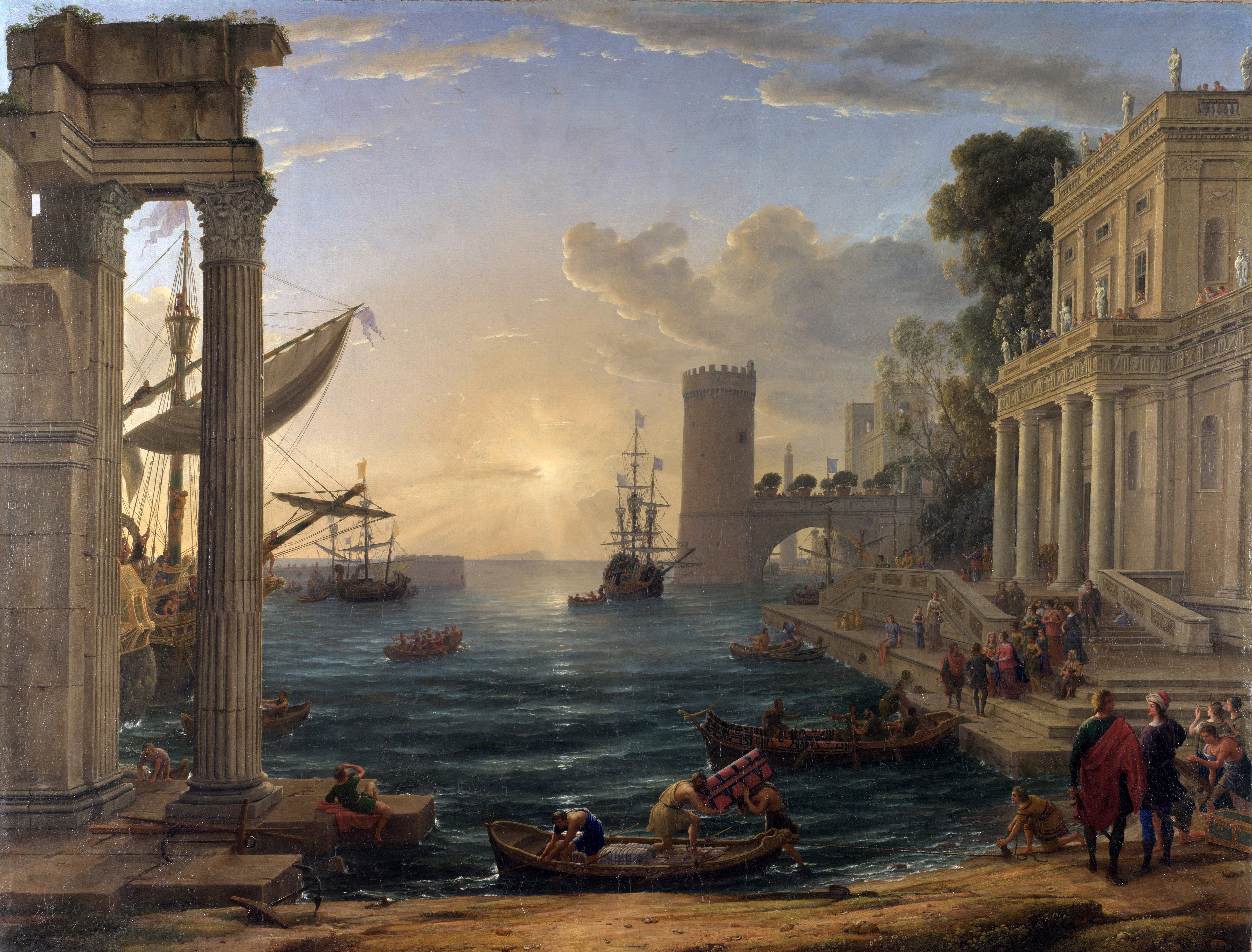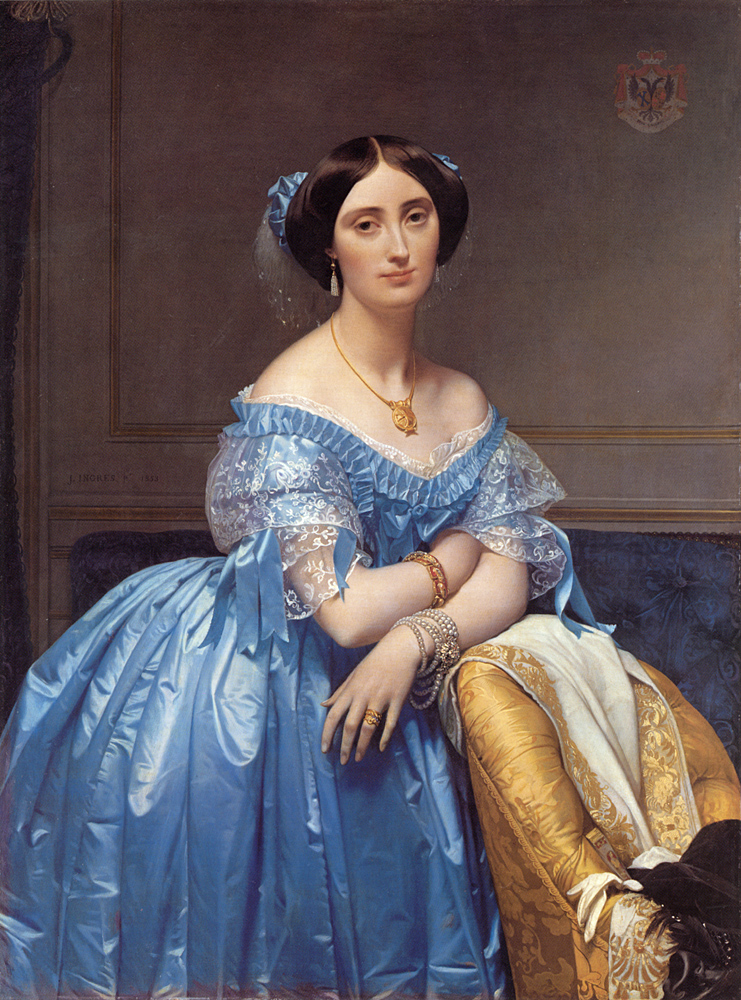Introduction
 |
| Roberto Borgheresi ph, CC BY-SA 4.0, via Wikimedia Commons Portrait of a Young Woman with a Unicorn - Raffaello Sanzio |
Across centuries, it manifested in various ways — from the serene frescoes of Raphael to the moral landscapes of Nicolas Poussin, the golden harbors of Claude Lorrain, and the disciplined historical dramas of Jacques-Louis David.
Whether in the High Renaissance or in the Neoclassical revival of the 18th and early 19th centuries, Classicism offered a counterbalance to the excesses of Mannerism, the high drama of Baroque, and the emotional turbulence of Romanticism.
This essay will explore Classicism’s defining techniques, palettes, and use of light; the artists who shaped and transmitted its ideals; and how they both absorbed and exerted influence. It will also closely examine seven significant paintings — one by each of seven different artists — in at least 200 words each, analyzing the technical and stylistic choices while noting the present-day market context for each.
Understanding Classicism
At its heart, Classicism is an aesthetic philosophy as much as an art movement. It emphasizes balance, proportion, intellectual clarity, and the pursuit of an idealized beauty that transcends the particular moment. Rather than chasing novelty for its own sake, Classicist painters sought to embody universal truths through measured design and disciplined execution.
The roots of Classicism lie in the art and architecture of ancient Greece and Rome, with their emphasis on harmony and proportion, as codified by thinkers like Vitruvius. The Renaissance — particularly through artists such as Raphael and Leonardo — revived these principles, demonstrating how painting could unite intellectual content with visual perfection.
In later centuries, Classicism became the official language of European academies, and in the age of Enlightenment, it was reborn as Neoclassicism, with painters such as Anton Raphael Mengs, Jacques-Louis David, and Jean-Auguste-Dominique Ingres giving classical ideals a modern voice.
Techniques, Palette, and Light
Major Painters of Classicism
-
Raphael (1483–1520): The High Renaissance master whose perfect balance of composition, anatomy, and serenity became the template for all later Classicists.
-
Nicolas Poussin (1594–1665): The intellectual father of French Classicism, known for moralizing narratives and austere landscapes.
-
Claude Lorrain (c. 1600–1682): The poet of light and idealized seaports, whose landscapes combined antiquity and atmospheric beauty.
-
Anton Raphael Mengs (1728–1779): A central figure in the Neoclassical revival, uniting theory and practice in a refined antique style.
-
Angelica Kauffman (1741–1807): One of the most celebrated female artists of the 18th century, blending classical themes with intimate sentiment.
-
Jacques-Louis David (1748–1825): The revolutionary history painter whose disciplined compositions became political icons.
-
Jean-Auguste-Dominique Ingres (1780–1867): The champion of perfect contour and line, continuing the Classicist tradition into the Romantic century.
Influence and Transmission
Classicism absorbed lessons from ancient sculpture, Renaissance composition, and the writings of humanist scholars. In turn, it shaped the training of countless artists through the academies of Europe. The discipline of drawing from antique casts, the study of anatomy, and the insistence on narrative clarity became standard.
Classicism influenced Romanticism by providing a structural discipline that some Romantics adopted even while rejecting its restraint. It shaped academic realism in the 19th century, providing the scaffolding for painters who would later explore more expressive or exotic subjects. Even modernists such as Picasso, in his “classical period,” drew upon the lessons of contour, proportion, and compositional order inherited from this tradition.
Seven Paintings — In-Depth Analysis
1. Nicolas Poussin — Et in Arcadia Ego
 |
| Nicolas Poussin, Public domain, via Wikimedia Commons And in Arcadia I |
The composition is architecturally planned, with the figures forming a contained, harmonious grouping.
Poussin’s brushwork is disciplined, his colors muted — ochres, olive greens, and cool stone grays dominate.
The light is even, allowing the viewer to contemplate the scene without distraction. The moral theme — even in paradise, death is present — reflects Poussin’s intellectual approach. The influence of ancient relief sculpture is evident in the poses, and the painting’s moral ambiguity inspired later artists to treat classical subjects with philosophical depth.
In today’s market, Poussin’s works are rare and prized; small oils and drawings command strong prices, often reaching into the high six or low seven figures when provenance and condition are exceptional.
2. Claude Lorrain — Seaport with the Embarkation of the Queen of Sheba
 |
| Claude Lorrain, Public domain, via Wikimedia Commons |
Figures are small in scale but carefully placed to suggest narrative. Claude’s technique involves thin glazes over a warm ground, allowing light to seem to radiate from within the paint layers.
His palette is anchored in warm ochres and pale blues, with touches of white to sparkle on water surfaces. The entire effect is one of poetic calm, blending human activity with a timeless setting. Such paintings redefined landscape painting, influencing generations from Turner to Constable. Today, authentic Claude Lorrain seaports are treasures of major museums, and when genuine works appear at auction, they can command several million dollars, especially if their provenance is well established.
3. Jacques-Louis David — The Death of Marat
 |
| The Death of Marat Jacques-Louis David, Public domain, via Wikimedia Commons |
David’s smooth handling erases visible brushwork, emphasizing sculptural clarity. The palette is limited — pale flesh against dark background, punctuated by the green cloth and warm wood tones. Light falls gently from the upper left, caressing the face and torso, creating a quiet dignity.
By applying classical compositional logic to a contemporary event, David fused art and politics in a way that shaped revolutionary iconography. While the original is held in a museum, David’s authenticated works command significant sums, with major paintings achieving several million dollars at auction.
4. Jean-Auguste-Dominique Ingres—Princess Albert de Broglie
 |
| Princess Albert de Broglie : Jean Auguste Dominique Ingres Metropolitan Museum of Art Manhattan, New York, USA |
Jean-Auguste-Dominique Ingres’s Portrait of Princess Albert de Broglie (1853) is a masterful example of 19th-century French portraiture, combining neoclassical precision with an almost photographic fidelity to detail.
Commissioned by Prince Albert de Broglie, the work depicts his wife, Pauline de Broglie, a member of the French aristocracy known for her beauty and intellect. Ingres, who by this point in his career was celebrated as one of the foremost portraitists of his age, approached the painting with his characteristic refinement, producing a work that both idealizes and immortalizes its subject.
The composition presents the princess seated in a three-quarter view against a neutral background, which draws full attention to her figure and attire. She wears an opulent blue silk gown with delicate lace trim, a shimmering fabric rendered with astonishing skill.
Ingres’s ability to capture the play of light on the folds of the dress demonstrates his technical mastery, while the meticulous depiction of textures—from the softness of the lace to the gleam of her jewelry—enhances the sense of realism. Yet the effect is not merely literal; the overall harmony of form and color elevates the sitter into an idealized realm..
5. Anton Raphael Mengs — Parnassus
Mengs’ ceiling fresco depicts Apollo with the Muses in an idealized classical setting, framed by painted architecture. Figures are arranged in a balanced rhythm, each carefully lit to read from below. The palette is light and airy, with soft blues, creamy whites, and warm flesh tones. Mengs’ technique emphasizes clarity over painterly flourish; each element is articulated with precision. His commitment to antique ideals made him a central figure in the Neoclassical revival, influencing both theory and practice. While his frescoes remain in situ, his easel paintings and portraits appear at auction and are valued in the mid to high six figures when quality and attribution are certain.
6. Raphael — The School of Athens
 |
| The School of Athens Raphael, Public domain, via Wikimedia Commons |
The philosophers are arranged in a grand architectural space, with vanishing points perfectly aligned to the central figures of Plato and Aristotle.
Color is used harmoniously: warm earths, rich blues, and deep reds create balance across the vast scene.
Light is consistent with the painted architecture, illuminating faces and gestures in a way that reinforces clarity. Raphael’s synthesis of narrative, composition, and idealized form became the ultimate standard for later Classicists. While the fresco is immovable, Raphael’s rare paintings and drawings are among the most valuable works in the art market, with prices for major works reaching tens of millions.
7. Angelica Kauffman — Virgil Reading the Aeneid to Augustus
 |
| Angelica Kauffmann, Public domain, via Wikimedia Commons Virgil reading the Aeneid to Augustus and Octavia |
Her brushwork is smooth, her colors refined — warm siennas for skin, soft blues and greens for drapery, accented with golds.
Light is evenly spread, fostering intimacy and calm. Kauffman’s work is a model of how Neoclassicism could carry emotional warmth without sacrificing compositional discipline. She was admired for bringing a feminine sensibility to the rigorous classical tradition, influencing tastes in both Britain and continental Europe. Her paintings are increasingly appreciated in the market, with high-quality examples reaching the mid-six-figure range.
The Market for Classicist Art Today
The great majority of iconic Classicist works are in public collections, beyond any market. When works by these masters do appear, their value depends on authenticity, condition, subject matter, and provenance. Raphael and Poussin occupy the highest tier, with exceptional works achieving multi-million sums. Claude Lorrain’s landscapes, when genuine and well-documented, can also fetch several million.
David and Ingres enjoy strong demand, particularly for autograph works, with high six to seven-figure prices common. Mengs and Kauffman, while less stratospheric in value, are seeing renewed interest, especially as scholars and collectors re-evaluate their roles in art history.
The market for Classicism is also influenced by broader trends: increased attention to female Old Masters, heightened scrutiny of provenance, and the continuing appeal of works that embody timeless ideals. For collectors, owning a Classicist work means holding a piece of the visual language that defined European art for centuries.
Conclusion
Classicism in painting is more than a historical style — it is an enduring language of harmony, proportion, and intellectual clarity. Its masters combined disciplined technique with narratives that could speak across ages, shaping the way art was taught, made, and understood.
From Raphael’s grand humanist visions to Poussin’s moral landscapes, Claude’s luminous harbors, David’s civic dramas, Ingres’ perfect lines, Mengs’ theoretical rigor, and Kauffman’s refined sentiment, the movement spans centuries yet retains a coherent spirit.
Today, Classicism continues to inspire, whether in the academy, in the art market, or in the eyes of viewers drawn to its serenity and balance. Its paintings remain touchstones for the ideals of beauty and truth — ideals that, much like the ancient art they emulate, remain timeless.
Keywords: Classicism painting, Neoclassicism, classical painters, Nicolas Poussin, Jacques-Louis David, Ingres, Claude Lorrain, Anton Raphael Mengs, Angelica Kauffman, Raphael — technique, palette, use of light, auction value.